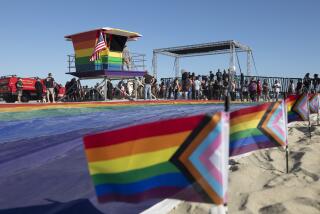A New Fight Brews Over Confederate Battle Flag
GULFPORT, Miss. â Classes started weeks ago, but Jason Whitfield is staying put on the beach.
For more than two months, the 21-year-old college student has kept vigil beneath a fluttering Confederate battle flag he says has no place being displayed at the county beach here. In his bid to get rid of it, Whitfield has become a central player in an emotional and escalating public tussle over the flag--an emblem of Southern heritage to admirers and a trademark of racist violence to foes.
Whitfield, who is black, and his allies say the battle flag carries a repugnant symbolism to so many people that it should not fly over land belonging to all. âAnyone who considers himself a God-fearing person should stand against this flag,â Whitfield said, sitting on a folding chair near a sign proclaiming Mississippiâs Gulf Coast the âPlayground of the South.â
Whitfield and others who want to remove the so-called rebel flag, which was carried onto the Civil War battlefield but was never the official banner of the Confederacy, have proposed replacing it with the First National Flag of the Confederate states. The replacement is less familiar--and less controversial--than the battle flag, but it would have more historical legitimacy, they say.
The Harrison County Board of Supervisors has voted to keep the familiar battle flag, red with a blue cross of St. Andrew containing 13 white stars. But in the face of mounting passions since Whitfieldâs protest, the supervisors decided this month to put the matter to a public vote, as a nonbinding referendum, when residents go to the polls Nov. 5.
Debating the proper place for the Confederate flag is hardly new in the South. Mississippi voters last year opted to keep the rebel flag emblem as part of the state flag. But amid the skirmishing here churns unease among business leaders who fear that the battle flag sends the wrong image about the modernizing Gulf region just as more tourists are flocking to the casinos and inns that have flourished along the white-sand beaches during the last decade.
Twelve casinos have taken root among budget hotels and majestic antebellum houses on Beach Boulevard since legalized gaming came to Harrison County in 1992. The casinos, some built on the sites of former seafood canneries that were a mainstay of the old economy, employ at least 16,200 people--more than half of the 30,000 tourism workers in Gulfport, Biloxi and a handful of other cities.
The beach area has been a resort stop for Southerners since plantation owners came from elsewhere in the state and nearby Louisiana more than a century ago. Now a growing number of visitors is drawn to the state from outside, as is new industry. The rebel flag in a public display presents an image problem, some say.
âIt doesnât really represent the community. The community we live in is a community of kind and fair people. That rebel flag has an image across the country of bigotry and racism. And thatâs not what weâre about,â said Aldo Morell, president of the Gulf Coast Economic Development Council, which last month was joined by the Gulfport Business Club in asking Harrison County officials to take the flag down. A third group, the Biloxi Businessmenâs Club, opted to sit out the debate.
William W. Martin, the Board of Supervisorsâ only black member in a county that is mostly white, has argued for replacing the battle flag. But the four supervisors who back the flag said they are honoring the wishes of constituents for whom the flag remains a link to forebears who died during the Civil War.
âIf weâre wrong, Iâll make the motion and weâll go down there to the beach the next day and take it down,â said Supervisor Bobby Eleuterius, who said the flag fervor tops anything he has seen during his 30 years in politics here. Eleuterius pulled out a nearly 2-inch-thick stack of letters and e-mail printouts; all but a few urged keeping the flag. âI canât go to the grocery store, the Laundromat or church,â he said. âPeople stop me and say, âStand tall.â â
Whitfield, a business administration major who would have begun his senior year at Alcorn State University in southwestern Mississippi, vows to remain as long as the flag does. Since he planted himself at the base of the flag July 10 with a cooler of ice and bottled water, Whitfield has prayed considerably, studied the Bible and the works of Gandhi, and lifted weights. He has eaten food donated by well-wishers and shrugged off racist epithets shouted by detractors. He has been the chief topic of on-air conversation at the radio station where his mother is a producer--causing some to suspect a publicity stunt--and been written up in the local paper and elsewhere.
Whitfield scoffed at suggestions that his sit-in is anything but a genuine effort to bring down a flag whose use by white-supremacist groups has made it what he calls âa representation of evil.â He said his protest is spiritual: âI look at this as a chance for people to choose--a good people versus bad people type thing. There is no middle ground.â
He said the flag could be moved down the street to Beauvoir, the final home of Jefferson Davis, the president of the Confederacy.
The National Assn. For the Advancement of Colored People has joined Whitfield and the business groups in seeking to replace the flag with the First National Flag of the Confederacy, or Stars and Bars, which has two broad stripes of red and one of white, with a blue canton containing white stars. Arrayed in opposition are the county supervisors and groups such as Sons of Confederate Veterans, which gathered more than 15,000 signatures in support of keeping the flag in place.
The battle flag is part of a display that includes eight contemporary American flags, plus the banners of eight governments--from France and Spain to the state of Mississippi--that have flown over the region since French explorers first came ashore at the end of the 17th century. It is in this group that the rebel flag flies. The display--the only one on county property--was left over from a former private amusement park.
âWe defend our right to honor heritage. Weâre not honoring slavery. That flag never flew over slave quarters or a slave ship,â said Ron Casteel, chief of staff of the Sons of Confederate Veterans. He said the group, based in Columbia, Tenn., resented the âmisuseâ of the banner by racist groups.
Opposition to the Gulfport flag prompted a lawsuit during the mid-1990s that ended with a court ruling allowing the county to continue flying it. The matter flared anew two years ago when the owner of the station where Whitfieldâs mother works took the flag down, leading to demonstrations for and against the symbol. County officials decided to remove the display and put up tamper-proof flagpoles. No sooner were the new poles erected last year than the Sept. 11 terrorist attacks on New York and the Pentagon occurred. In support of the anti-terrorism war, the countyâs supervisors hoisted only American flags. Then, in July, they voted 4 to 1 to return the eight historical flags, including the rebel banner.
The next day, Whitfield skipped work, grabbed the cooler and a blanket and assumed his perch. While praying, he said, he decided to remain, except for a daily trip home to bathe. He is joined by friends and supporters, who bring food, and by opponents, who plant rebel flags in the sand on the opposite side of the display. There has been debate across the divide, and two incidents in which snakes were released near Whitfield.
Whitfield and his backers are pessimistic about winning the flag vote. They say the next step could be a call for boycott, such as one the NAACP has waged with limited success in South Carolina to protest a Confederate flag on state-government grounds.
For now, Whitfieldâs schooling will have to wait.
âMaybe Iâll be able to make it back by January,â he said. âBut if that flag is still here, Iâll still be here.â
More to Read
Sign up for Essential California
The most important California stories and recommendations in your inbox every morning.
You may occasionally receive promotional content from the Los Angeles Times.










